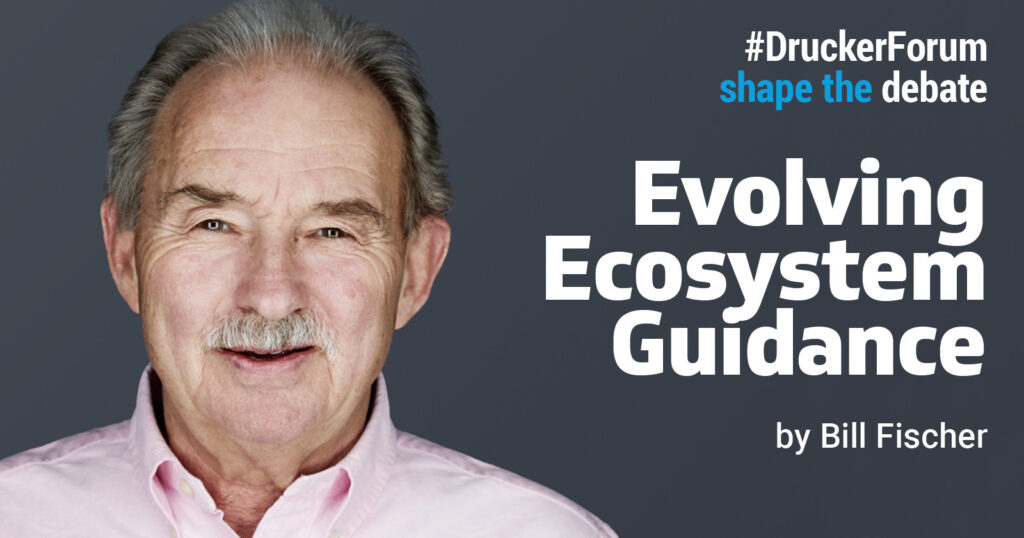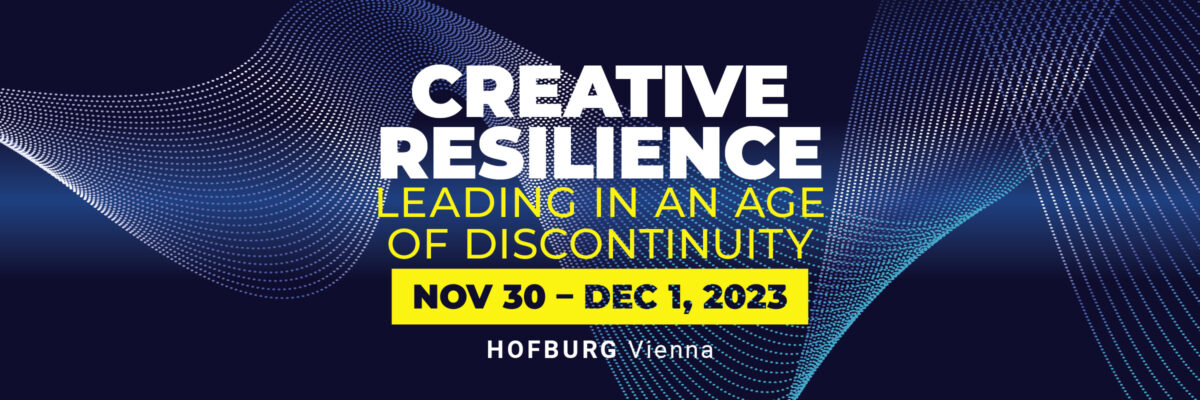
“Water! Build your organizations so that they move like water.”
This advice from Haier’s Chairman Emeritus, Zhang Ruimin, began a search for useful guidance for treating ecosystem engagement as a strategic asset for the future. Ecosystems are an ageless phenomenon, newly rediscovered for commercial purposes, by James F. Moore, in 1993. Once multi-geographic trade began, the ancient world was held together by interwoven threads of economic activity. As these linkages became more reliable, ecosystems bloomed.[1] Today, ecosystems are emerging as a central part of moving into an ever-complex future, but they are still too new to our understanding to establish “rules” for ecosystem engagement. Nonetheless, we are seeing useful observations reflecting lessons learned, that begin to form the basis for thinking more analytically about how to design and engage with effective ecosystems.
- Ecosystems are about optimism, exploration, and growth. Dr. Moore emphasized the power of optimism when he observed that “Haier looks at its employees and rather than seeing fixed costs, sees unlimited possibilities, instead.” This is exactly the spirit of optimism that powers a growth-mindset throughout an entire ecosystem; it’s opportunities, not constraints, and then crafting relationships to act on them, that characterize successful ecosystem mindsets.
- Ecosystems are not value-chains. Although they might appear to be related, almost everything about ecosystems differs from value-chains. Value-chains are fashioned for command and control. Ecosystems are more suitable for pursuing unforeseen opportunities. Value-chains have “tiers” with expected outcomes; in effective ecosystems, everyone has unlimited options, and opportunities. Value-chains are closed; ecosystems are open. Julian Birkinshaw, recognizing that more ecosystem members are more valuable than fewer, has suggested that, for fashioning ecosystems, protective moats (barriers to entry) should be exchanged for more open “turnstyles.”
- Ecosystems are inherently non-linear. Not only are ecosystems unlike value-chains, they are non-linear. Alan Moore’s book No Straight Lines has emphasized the power of not imposing predetermined outcomes upon a community of potential co-creators. The whole idea of ecosystems is to break-out of the tyrannical linear constraints of value-chains.
- Ecosystems should be centerless. Every ecosystem has a distribution of members, whose attributes, including size, brand, access to resources, future-orientation, daring and other such indicators of organizational predisposition, help us anticipate the value a member potentially brings, and some hints regarding its likely behaviors. It is easier for bigger members to act as if they have more power, but in the ideas game, size is not necessarily associated with idea fecundity, and the more that any one member assumes a greater say in how the ecosystem works, the less likely the ecosystem will be to benefit. Indeed, the more centered an ecosystem is around one member, the more likely it is to devolve into a value-chain for that member.
- Leverage points are easy to identify, but the correct actions should take a system-wide perspective, rather than an isolated nodal (or client) perspective Centerless systems, however, does not mean that there are no leverage points for effecting change. These, within a complex system, are “those places where a small shift in one thing can produce big changes in everything.” Donella Meadows, who has studied systems at all levels of complexity, argues that the most effective leverage point, in any system, is “The mindset or paradigm out of which the system — its goals, power structure, rules, its culture — arises.” This means dispensing with trying to fix a node, and focusing, instead, on trying to understand the whole pattern of relationships that characterize a particular ecosystem, and its underlying logic and beliefs. Ironically, this often results in recognizing that what seems naturally intuitive from the perspective of any particular node, is often sub-optimal from the perspective of the system as a whole.
- Temporaryiness. Ecosystems should also be considered temporary, or always in flux; engaging in temporary liaisons as the relationships with customers change. More than five decades ago, Warren G. Bennis and Philip E. Slater alerted us to the imminent arrival of The Temporary Society: “adaptive, rapidly changing temporary systems…. groups of relative strangers with diverse professional skills…. Arranged on an organic rather than mechanical model, they will evolve in response to a problem, rather than to programed expectations.[2]” What they saw in the future, is our present, and expresses a need for spontaneity in organizational direction; not random, but purposeful searching for the next most promising opportunity.
- Successful co-creation requires that there be a sharing of the outcomes, as well as the inputs. Unlike the provision of products or services, participation in the creation of new ideas comes with the expectation of full commitment of time, effort and brainpower. The ecosystem projects, that Haier’s microenterprises are partners in, establish the shares of future outcomes that will be distributed, so that opportunity becomes a magnet that draws members in, and binds them together.
- Ecosystems are often hidden in plain site; invisible, and thus less effective than they could be. The irony is that ecosystems are already all around us, and have been always. Most ecosystems emerge organically; remain informal, invisible, yet reliable; and take on a life of their own as new needs and capabilities arise. This is what Moore spoke about in his seminal article on business ecosystems, when he wrote “A business ecosystem, like its biological counterpart, gradually moves from a random collection of elements to a more structured community.” Our work on the Esports ecosystem in the Greater Copenhagen region[3], revealed an existing ecosystem that was already functioning, but was unheralded. Organizations bonded, and unbonded, as their individual situations changed. It was unlikely that anyone involved actually thought of it as an ecosystem, and It was operating as a network so far from Pareto optimality, that there was no inducement to adopt an ecosystem-mindset. As a result, it undoubtedly underperformed for most of its participants. Our belief was that the simple act of recognition of the bonds that were taken for granted, could only improve the linkages and understanding between the participants.
- Networks-within-networks, “many-to-many,” arrangements could be the real promise of ecosystems. Temporary, centerless ecosystems increase the possibility of groups of members coming together, even briefly, to address the needs of a potential client base. Such “many-to-many combinations were described in 2001, by computer scientist David P. Reed, who argued, that the value of ecosystems with group forming networks (GFNs) increases exponentially in proportion to 2n, where n equals the total number of members. Reed envisioned “.. customers band[ing] together to request customized products and services from suppliers, and they can help suppliers organize alliances to create new products and services.” This GFN behavior can already be seen in Haier’s Internet of Food, and Internet of Clothing.
- Focus on the links, not the nodes. The formation of GFNs suggests a degree of fluidity in brand-allegiance, employment and group formation and dissolution to allow such spontaneity. In ecosystems characterized by an increased reliance upon autonomous, microenterprises, that generate their own income, a recognition of higher-order outcomes and beliefs has become evident, to the extent that what happens in any one connected unit is not as important as the linkages between units. Zhang Ruimin, when asked what will be Haier’s key assets twenty years from now, responded “our relationships.”
- The health of an ecosystem is measured by the opportunities for all that result from their collaboration. With any biological ecosystem, the health of the entire system matters more than any one member, keeping in mind that all members are linked to each other, directly or indirectly, by the contributions that they make to the system as a whole. The overall health of a business system should be associated with the overall opportunities that ecosystem membership provides for all. James F. Moore concluded his article on ecosystems with the sobering thought that “From an ecological perspective, it matters not which particular ecosystems stay alive; rather, it’s only essential that competition among them is fierce and fair—and that the fittest survive.”
- Being like water Ecosystems are different enough from traditional business practices that it makes little sense to believe that present-day organizations, or leadership mindsets, are well-prepared for them. Zhang Ruimin’s suggested “being like water” serves as a useful metaphor for designing organizations that can function effectively, and opportunistically, in ecosystems that are open enough to celebrate co-creation. Simone Cicero, of Boundaryless realizes that organizations that function in a traditional and linear, two-dimension, world, might not be at all suitable for the three-dimensional possibilities of ecosystem involvement. He argues for building ecosystem-enabled enterprises that are better-suited for the opportunities and faster-paced cadence of embracing ecosystem partners. This is not for the faint-hearted, but is essential for the major shift in management that ecosystems require and deserve.
[1] Amitav Ghosh” In An Antique Land, brings to life how ecosystems worked in linking 12th Century East-Asia to the Egyptian world.
[2] Warren G. Bennis and Philip E. Slater, The Temporary Society, New York: Harper-Colophon Books, 1968.
[3] Anouk Lavoie and Bill Fischer, “How Copenhagen launched an Esports ecosystem,” IMD Case IMD-7-2102.
About the author:
Bill Fischer is a long-term member of the Drucker Forum community. He is a Professor Emeritus of Innovation Management, at IMD, and a Senior Lecturer at MIT’s Sloan School of Management. Bill has a long-term consulting relationship with the Haier organization.

